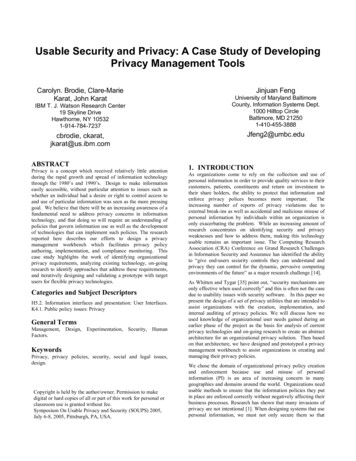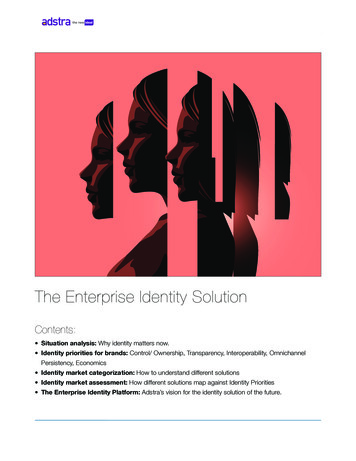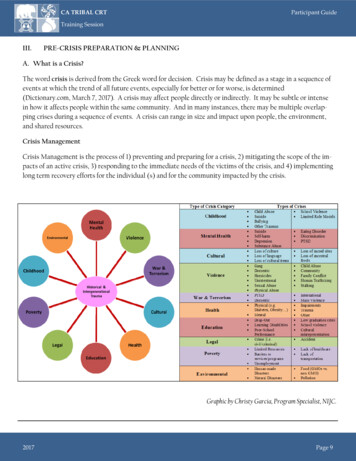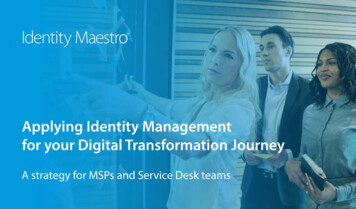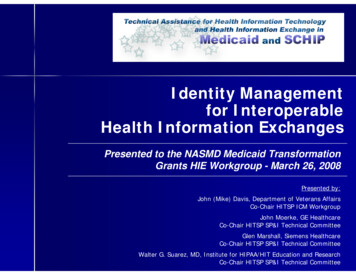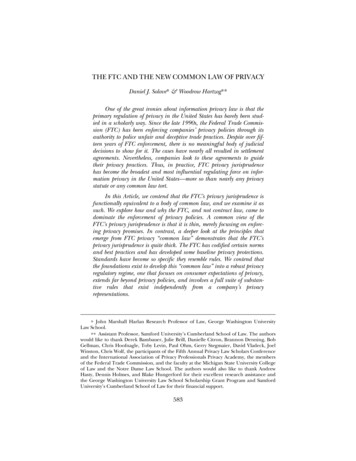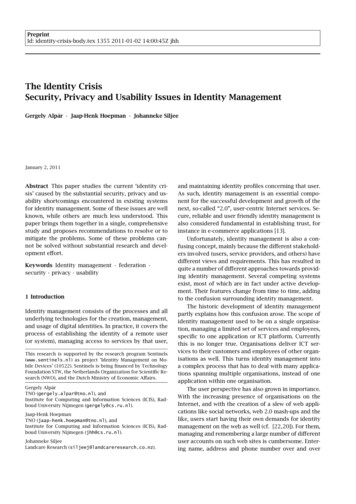
Transcription
PreprintId: identity-crisis-body.tex 1355 2011-01-02 14:00:45Z jhhThe Identity CrisisSecurity, Privacy and Usability Issues in Identity ManagementGergely Alpár · Jaap-Henk Hoepman · Johanneke SiljeeJanuary 2, 2011Abstract This paper studies the current ‘identity crisis’ caused by the substantial security, privacy and usability shortcomings encountered in existing systemsfor identity management. Some of these issues are wellknown, while others are much less understood. Thispaper brings them together in a single, comprehensivestudy and proposes recommendations to resolve or tomitigate the problems. Some of these problems cannot be solved without substantial research and development effort.Keywords Identity management · federation ·security · privacy · usability1 IntroductionIdentity management consists of the processes and allunderlying technologies for the creation, management,and usage of digital identities. In practice, it covers theprocess of establishing the identity of a remote user(or system), managing access to services by that user,This research is supported by the research program Sentinels(www.sentinels.nl) as project ’Identity Management on Mobile Devices’ (10522). Sentinels is being financed by TechnologyFoundation STW, the Netherlands Organization for Scientific Research (NWO), and the Dutch Ministry of Economic Affairs.Gergely AlpárTNO (gergely.alpar@tno.nl), andInstitute for Computing and Information Sciences (ICIS), Radboud University Nijmegen (gergely@cs.ru.nl).Jaap-Henk HoepmanTNO (jaap-henk.hoepman@tno.nl), andInstitute for Computing and Information Sciences (ICIS), Radboud University Nijmegen (jhh@cs.ru.nl).Johanneke SiljeeLandcare Research (siljeej@landcareresearch.co.nz).and maintaining identity profiles concerning that user.As such, identity management is an essential component for the successful development and growth of thenext, so-called “2.0”, user-centric Internet services. Secure, reliable and user friendly identity management isalso considered fundamental in establishing trust, forinstance in e-commerce applications [13].Unfortunately, identity management is also a confusing concept, mainly because the different stakeholders involved (users, service providers, and others) havedifferent views and requirements. This has resulted inquite a number of different approaches towards providing identity management. Several competing systemsexist, most of which are in fact under active development. Their features change from time to time, addingto the confusion surrounding identity management.The historic development of identity managementpartly explains how this confusion arose. The scope ofidentity management used to be on a single organisation, managing a limited set of services and employees,specific to one application or ICT platform. Currentlythis is no longer true. Organisations deliver ICT services to their customers and employees of other organisations as well. This turns identity management intoa complex process that has to deal with many applications spanning multiple organisations, instead of oneapplication within one organisation.The user perspective has also grown in importance.With the increasing presence of organisations on theInternet, and with the creation of a slew of web applications like social networks, web 2.0 mash-ups and thelike, users start having their own demands for identitymanagement on the web as well (cf. [22, 20]). For them,managing and remembering a large number of differentuser accounts on such web sites is cumbersome. Entering name, address and phone number over and over
2again with every e-commerce site should be avoided.And finally, the identity management systems to support their use of web applications in a variety of contexts should be privacy friendly.Current systems for identity management do notsatisfy these requirements yet. Apart from the fact thatproperly implementing an identity management systemspanning multiple organisations is very complex, thedesign of current identity management systems is already broken at a more fundamental level. They sufferfrom several shortcomings that need to be addressedbefore they can be considered truly secure, privacy friendlyand usable. Some of these issues are well known, whileothers are much less understood. This paper bringsthem together in a single, comprehensive study andproposes recommendations to resolve or to mitigatethem, in order to end the current identity crisis.1.1 Reading guideThe paper is organised as follows. Sect. 2 gives a shortoverview of identity management and the state of theart in identity management research. In Sect. 3 we describe fundamental shortcomings in current identitymanagement designs. These concern the concept of identity itself, and the sometimes implicit trust assumptions on which these designs are based. We continueour investigation discussing security (Sect. 4), privacy(Sect. 5) and usability (Sect. 6) issues, and wrap up withan overview of our conclusions and recommendationsin Sect. 7.2 On Identity managementIdentity management (or IdM for short), consists of theprocesses and all underlying technologies for the creation, management, and usage of digital identities. Ina typical identity management system we can distinguish three parties: users, identity providers and relying parties1 . The user (U) requests a service from theRelying Party (RP) that relies on the Identity Provider(IdP) to provide authentic information about the user.These are three technical components, which cannot beheld legally accountable. We therefore use the notion ofdomain to represent a legal entity (an organisation orindividual person), that is responsible and accountablefor the activities of a technical component.In this paper we loosely define identity as follows.The identity of an entity within a scope is the set of all1Relying parties are also known as service providers (SP).characteristics (also called attributes) that have been attributed to this entity within that scope [19]. An identifier uniquely identifies an entity (a person, a computer,an organisation, etc.) within a specific scope. We willcome back to this distinction later on in Sect. 3.1.Several types of identity management systems exist [27, 30]. We choose to make the distinction betweennetwork-based identity management and claim-basedidentity management (see Fig. 1), because their difference in architecture has an impact on the security, privacy and usability issues associated with them (cf. [34]).In a network-based IdM system, the procedure toaccess a service and to determine the identity and attributes of the visiting user roughly runs as follows.When the user visits the RP, the RP asks the user toauthenticate himself at the IdP. The IdP performs thisauthentication, and if successful gives the user a tokenthat the user forwards to the RP. The RP verifies thetoken, and if valid, accepts the user as authenticated.To obtain further identity information about the user,the RP contacts the IdP directly, using the token as apointer to the user profile stored by the IdP. In somecases, the user mediates this exchange of informationbetween IdP and RP.Examples of network-based identity management systems are OpenID2 , the Liberty Alliance3 , and Shibboleth4 .In claim-based IdM systems a RP specifies the userinformation it needs in order to grant the user access.The user decides if and how it will comply with that request, by obtaining so-called claims from IdPs. A claimis a statement about a user (similar to an attribute assertion in SAML 2.0), expressed (and signed) by an IdP.To obtain such claims, the user needs to authenticatehimself to the IdP, and after receiving the claim fromthe IdP the user forwards the claim to the RP.The crucial difference with network-based IdM systems is that there is no direct exchange of informationbetween RP and IdP, giving the user more control overthe exchange of his identity information. Even thoughthere exist policy tools such as uApprove5 for networkbased IdM systems that allow a user to deny or giveconsent to releasing his attributes to a RP, the actualattribute assertion exchange still takes place by the RPand IdP communicating with each other directly.Examples of claim-based identity management systems are the Identity Metasystem (Windows CardSpace)[9, 26], and more privacy friendly concepts from u/5Developed for Shibboleth by SWITCH: ml3
3IdPIdP U RP request serviceoptional step authenticate at IdP exchangeadditional info authentication result U‘cachable’ steps authenticate send claimsnetwork-basedRP request service send policysupply claimsclaim-basedFig. 1 Types of identity management systems.academic community like Idemix [6, 5] and U-Prove [4].In the latter two cases, claims are in fact anonymous,and are not transferred to the RP directly. Instead, thestatement in the claim is proven to the RP in a zeroknowledge fashion. This further protects the user’s privacy, because it makes the user unlinkable between twointeractions with a relying party.The main points raised in this paper apply to all current types of identity management systems, althoughto claim-based approaches to a lesser extent. In generalclaim based approaches exhibit less privacy issues, andhave a slightly better security and usability profile.2.1 Federated identity managementThe concept of federated identity management is sometimes cause for confusion. At times the term is used todescribe the collaboration of several RPs to use a singleIdP, all within the same domain. In our view such a setupis the standard form of identity management, where noreal federation takes place. Instead, federated identitymanagement is a setup where identity is shard acrossdomains [25, 18]. Within such a federation, additionalagreements can be made for further optimisation, e.g.to have a centralised authentication authority. The socalled circle of trust (CoT) equals the set of domainsthat belong to one federation. Note that a domain canbelong to several federations and therefore can belongto several circles of trust. Fig. 2 shows the differences.Example federations are national education and research federations based on Shibboleth (e.g. Austria’sSWITCH, UK Federation, Australian’s AAF, USA’s InCommon), or Liberty Alliance (Geofederation). Much work isundertaken on inter-federation: technologies and policies to allow users from one federation to be acceptedby another federation. This takes place both technologically, e.g. Microsoft’s Geneva inter-operates with Shibboleth, and on a policy level, to let e.g. national researchfederations share resources6 .2.2 Related workSeveral other studies have stressed the importance ofprivacy, security and usability of identity management,each focusing on specific issues or looking at the problem from a particular perspective.Pfitzmann and Hansen [33] have been collecting anddeveloping a consolidated terminology about the fundamental concepts in relation to digital identity andidentifiability since 2000; the evolving paper is currentlyat its 34th version.Public awareness about what private information canbe stored and resold by RPs is very low and the customers’ view is more optimistic than reality accordingto the survey by Turow et al. [36] Nevertheless, customers do care about their private data and they arewilling to take privacy into consideration in purchasing decisions when information about the privacy statement of the retailer is easily accessible and sufficientlyuser friendly [35].Paul De Hert [12] argues that a paradigm shift is necessary in connection with private data. Retailers, governments and other organisations have to accept thatprivate information is ultimately owned by the individual who has to be assigned the control over her private data. Privacy has to be a part of the legal framework as well as when designing new systems that comprise personal data. The fundamental technical means,6see TERENA REFEDsactivities/refeds/athttp://www.terena.org/
4circle of trustdomaindomain AdomainRPRPRPURPUIdPRPURPIdPRPRPRPIdPRPidentity silo’sRPRPdomain Bidentity managementfederated IdMFig. 2 Federation in identity management.the cryptographic tools, are available to build privacyenhancing systems with anonymous but accountableusers [6, 4].Privacy itself also raises many questions to study.Recent endeavours show the different aspects that identity management has to take into consideration. Pearson [31] collects design guidelines for cloud computing services with proper privacy protection and she describes some open questions (e.g. policy enforcement,determination of data processor, constructing privacydesign patterns). Another emerging research field is thechallenge of building life-long privacy [32] that includesthe expansion of solutions to most areas in life and verylong-term data security too.Dhamija and Dusseault [14] provide guidelines abouthow to design a decentralised web identity management system that will take all participants’ motivationas well as their capabilities into account. They assertthat the usability aspect is essential in order to achievewide acceptance and secure usage of such a system, allowing users to take appropriate privacy decisions.Although federated identity management solutionsare widely employed in corporate and academic environments, many problems still arise. These systems canprovide convenient user functions (such as single signon or automated form-filling), however, the single layerof authentication decreases system security [1] while itincreases the value of user credentials (as it providesaccess to more resources) [14].One of the most challenging research tasks is howto build a privacy-friendly IMS with good usability properties. Technical research recommends usable privacyenhancing solutions. Josang et al. [20] proposes a schemethat includes a personal authentication device (PAD)that claims to be able to support both secure singlesign-on and protection against phishing attacks. A similar tool, a “smart client”, is predicted to gain increas-ing importance that assists the discovery of appropriateIdPs in complex federated systems [25]. In the EuropeanPRIME project Camenisch et al. [7] developed an elaborate system that provides more control for users abouttheir personal data by automated negotiation processes.Eclipse’s Higgins7 — with a practical open-source approach — is a project in progress that is aiming forimplementing a user-centered identity framework fordiverse platforms with a consistent user interface.Ongoing research in IdM encounters many challengesconcerning the balance among security, privacy, usability. A suitable legal framework is required that workstogether with technical solutions [12] and which provides liability incentives [24] for stakeholders. A usablesolution for mutual authentication is still to be developed in which not only users are required to providecredentials but IdPs and RPs are also authenticated tothe users [20, 24].The Future of Identity in the Information Society(FIDIS)8 Network of Excellence provides a wealth of information on the topic, see for instance [27] for a systematic review of current systems for identity management. Based on their experiences within that project,Cameron et al. [10] propose a framework for a usercentric, privacy friendly, IdM, with a focus on ensuring interoperability. Their proposal is very much in linewith the US National Strategy for Trusted Identities inCyberspace [13].3 Fundamental issuesThere are several fundamental problems with identitymanagement systems that arise from the illusive nature of the concepts of identity and trust. Also, too is.net
5tle consideration has been given to the different typesof access rights that must be enforced through identity management, as they prove to have an impact onthe trust relationships between the parties involved. Because of their fundamental nature, these issues apply toall current models of identity management, and not justthe current implementation of such models. We discussthese issues in this section.Virtual identities, in the virtual world, can be connected to entities in the real world, but this connection may be loose. For example, computers behind anIP address may be replaced. Ownership of game characters or avatars may be transferred between people overtime. In fact, there is quite a large amount of trade insuch virtual identities. Likewise, functional roles withincompanies may look, to external observers, as entitieswith a particular identity, but different people may actually be assigned to such a role over time.3.1 What is identity?Identity is also dynamic. Assertions about someone’sage change when time passes. Your financial situationchanges over time, so do your friendships, your convictions and beliefs. Identity management systems mustdeal with such changes efficiently, and must avoid keeping old invalid data.We first turn to the concept of identity itself (cf. [3]).Note that identity is not absolute. An identity describes an entity (a person, a computer, an organisation,etc.) within a specific scope. More formally: The identityof an entity within a scope is the set of all characteristics that have been attributed to this entity within thatscope (cf. [19]). For example, you may have one identity within the scope of your job, containing information such as your employee number, and another identity within the scope of your family, containing information on the food you like. Identities are thereforeonly valid within a specific scope. If an identity contains many characteristics, it may uniquely identify aparticular entity within a scope. However, with only afew attributes, many entities are likely to match.It immediately follows that entities have, in general,multiple identities. These identities may partly overlap,but can also be mutually inconsistent. One of the authors has blue eyes in all scopes, but may go by different names, nicknames, in different scopes. In extremecases, people are known to live parallel lives. Sometimes, hardly anybody knows that particular identitiesin different scopes belong to the same entity.Identity is not unique. Even within a single scope,people may have several different identities. Within thescope of a family a person may not only be a father (tohis children) but also a husband (to his wife). Moreover,the identity of an entity is perceived differently by different people, or perceived differently by the same people at different times or in different contexts. Someonemay be trusted by one person, but not by another, oronly within a certain context.To uniquely identify entities, one needs to rely onidentifiers, not on identities. This distinction betweenidentity and identifier is important, and not always properly understood. The confusion is understandable, because in common parlance identity is almost synonymous with personal name, which in turn is understoodto be a unique identifier. Note that also identifiers (suchas a user name) are only valid and guaranteed to beunique within a scope.Identities may exist long after an entity ceases to exist. The lifetime of an identity does not correspond tothe lifetime of the associated entity. Most of the timeidentity information is not updated or deleted after ithas become inapplicable. This introduces a privacy risk.But sometimes claims about an entity actually need tobe kept long after the entity itself disappears. For accountability reasons, relying parties store usage information for a period of time, sometimes several years.The situation is reminiscent to the difference in lifetimes between keys and certificates (themselves a possible part of an identity). A certificate needs to be keptlong after the key it certifies has expired, to allow parties to verify the signatures made with that key.Identity is not only what you want to reveal aboutyourself, but also what others conclude, believe, andfind out about yourself. In fact most of a person’s identity is of this type. Such data may be wrong, becomeinvalid over time, be misrepresented, or be misguiding,etc. In other words, an identity does not necessarily correspond to reality. Moreover, it shows that an identityhas many owners: it is not only owned by the entity itdescribes, but also collected and owned by others. Afine example of this are your health care records thatare being collected by GPs, specialists and other healthcare personnel. Health records are owned by (and theresponsibility of) the GP. You may have the right to viewthem, but you don’t necessarily have the right to changethem. This has important privacy ramifications.Instead of an entity having one single identity containing all characteristics taken from all scopes, it ismore natural to view an entity as a collection of multiple identities (a set of sets), each with their own scope.Note that this aligns with the idea that privacy ensuresthat information about a person does not leak from onescope into another.
6When scopes merge (e.g. if organisations merge) identities may clash. If an entity has an identity in bothscopes they may not get merged at all, and as a resultthe new scope perceives two entities where there is onlyone. For example, a person may have an account withtwo different RPs, which require the user to use different IdPs. How to determine what an entity’s identity isin the new scope when the two RPs merge? Or when thetwo IdPs merge?The fact that identities remain to exist long after theentity ’dies’ can result in a wealth of personal information stored in many places, leading to privacy risks forusers that are somehow related to this entity. It mayalso result in IdPs giving out incorrect claims, damaging their reputation of a trusted partner that needs to beright always. Furthermore, claims (that link some identity information to an identifier) may continue to existindefinitely, even after the identity information itself isdeleted. When the claim of an old identity still existsand a new identity is created with the same identifier,these two may seem to refer to the same entity, whilethis is not the case.Managing identities does not only mean handlingnew and fixed identities within one scope, but also handling the complex situations of changing identities inchanging scopes, and managing the different perceptions of identity within the same scope. This is a challenge.Recommendation A proper model for identity underlying identity management should be developed, and IdPsand RPs should make explicit how that model appliesto their systems of identity management.Identity management systems should distinguish between the lifetime of an identity, and the lifetime ofclaims derived from that identity. They should also provide a way to remove obsolete identities (or part ofidentities) and to invalidate out-of-date claims. Identity management systems should use proper identifiersthat satisfy the requirements from Joosten et al. [19].To deal with dynamic identity aspects, it would beconvenient if a person could get an attribute certificatefor, for example, the date of birth, which could then beused to prove that the person is older than 18 (withoutrevealing the real age). An example implementation ofsuch a system is Idemix [5].3.2 Different types of accessIdentity management systems are being used to enforcedifferent kinds of access rights. These access rights havedifferent risk profiles, and therefore assume differenttrust relationships between users, identity providers andrelying parties. Unfortunately, users as well as systemdesigners are unaware of this difference in access rights.This results in unacceptable risks.The essential distinction one needs to make is between membership and ownership of a resource.Identity management systems were first applied inorganisations (to centralise access rights managementto business applications) and education (to grant students access to the wireless network, the digital libraryand the computing facilities). In both cases, the identitymanagement systems are used for deciding whether acertain user is a member of a group. In the first case itdecides whether the user is a member of the group thathas access to some business application. In the secondcase it decides whether the user is a student of a certainuniversity. The resource being controlled is not ownedby the user, and any risks or resource damage due tousing the identity management system lies completelywith the relying party, not the user.More and more, identity management systems arealso being used to enforce ownership of a resource. Theprime example is on-line banking, and to a lesser extent email, chat, blog and social networking accounts.Illegal access to your bank account will hit you with a direct financial loss. Access to your email, chat and othersystems may enable a criminal to ’steal’ your identity,which may hurt you in many other ways. In this case,the risk of using the identity management systems liescompletely with the user.How does this affect the use of identity management systems? To enforce membership, identity management needs to assume different trust relationshipsthan to enforce ownership. In the first case, the relyingparty needs to trust the identity provider to reliably authenticate its members. In the second case, it is the userthat needs to trust the identity provider to reliable authenticate himself. These trust relationships need to beenforced either by technological means, or through mutual agreements like service level agreements (SLA) withassociated penalties. In either case, an identity management system to enforce membership is inherently different from an identity management system to enforceownership.Also the risk level associated with using identitymanagement differs. In the case of granting studentsaccess to university resources, the damage associatedwith abuse (and therefore the risk of using identity management systems) is quite low. Except for extreme, denialof-service cases the university does not suffer any direct actual loss of non-students having access to theresources. This is the same for any subscription baseddigital service, like on-line music, or a digital newspa-
7per, etc. Because the marginal cost of the copy is essentially zero, there is no direct loss if non-members haveaccess as well. The losses incurred by such services arethe result of fewer sales.Granting access to business applications (and theassociated data in particular) has a higher risk profile.Not because of loss of revenue, but because the datais often confidential. It could cause enormous financialdamage when it becomes public. Similarly, there is a difference in risk level associated with granting access to abank account and granting access to an email account.Recommendation The impact of dealing with differenttypes of resources on IdM deserves further study. Forinstance, related distinctions one could make here areon rivalry and durability of a resource. A rivalrous resource cannot be used at the same time by anotheruser, whereas access to a nonrival resource does notexclude such access by others (cf. common property resources). Durable resources do not degrade or get usedup, whereas non-durable do degrade or can be used onlyonce (cf. the difference between ’bits’ and ’atoms’). Itis interesting to explore the economic literature to seewhether even more types of resources and goods canbe discerned, and how they influence the trust assumptions in (and the risk of using) identity management.way around) in different sessions. In order to do so,both parties need to retain information from sessionto session. Unfortunately, in many of the current IdMsystems, the User does not maintain any state. Moreover, the RP is completely relying on the IdP to ensurethat the link between different visits of the same useris reliable10 (but see also [16]).The "proof key" of CardSpace [26] does not solvethis: this only prevents an adversary to use a securitytoken it obtained illegally11 . The binding is only guaranteed as long as the IdP is honest. If the IdP releasesthe private proof key, or if it uses that proof key itself,the UA is no longer involved.The problem could be solved if the User Agent andthe Relying Party each store part of a key pair, and verifythe link directly without external help.3.3.2 Trust assumptions are ill understoodBy using an identity management system, one implicitly agrees to several complex, and poorly understood,trust relationships between the parties that belong tothat identity management system. Some of the trustrelationships involved in identity management are theside effect of more fundamental security and federationproblems, that we will discuss separately.3.3 Trust assumptionsWe have been using the ambiguous concept of trustin previous sections, without giving a definition. Wewill not present a thorough discussion of the notionof trust in this paper though, but refer to Hardin [17]O’Hara [29] and others9 . For our exposition the following informal definition (taken from van den Broek andHuijboom [37]) is sufficient:When an actor trusts another actor, he or she iswilling to assume an open and vulnerable position. He or she expects the other to refrain fromopportunistic behaviour even if there is the possibility to show this behaviour.In more technical terms, entity A trusts entity B if Bcan break the security or privacy policy of A withoutA’s cooperation or knowledge. Similar definitions canbe found elsewhere (cf. [21]).3.3.1 Building trustTrust can only be built over time. For this, the RP needsto be sure it is talking to the same entity (and the other9Lacohee, H. Crane, S. and Phippen, A. Trustguide: Final report, at http://www.trustguide.org.uk.The user trusts the IdP not to act on its behalf without hisexpli
2 On Identity management Identity management (or IdM for short), consists of the processes and all underlying technologies for the cre-ation, management, and usage of digital identities. In a typical identity management system we can distin-guish three parties: users, identity providers and rely-ing parties1. The user (U) requests a service .


